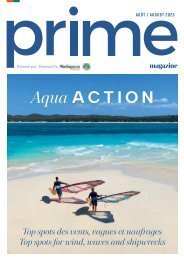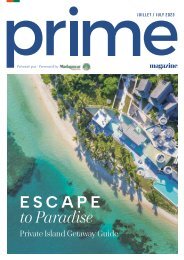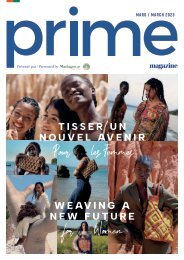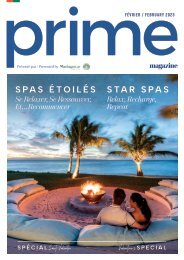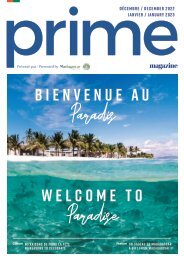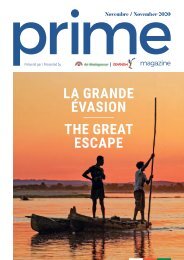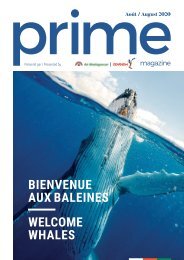Prime Magazine March 2020
You also want an ePaper? Increase the reach of your titles
YUMPU automatically turns print PDFs into web optimized ePapers that Google loves.
FEATURE<br />
BETSIMISARAKA<br />
Nombreux inséparables. Situé dans le littoral Est, entre<br />
Mananjary et Vohémar, ce groupe a une culture et des<br />
traditions très riches. Ils ont élu domicile sur la côte<br />
Est de Madagascar, entre l’Océan Indien et le canal des<br />
Pangalanes.<br />
Many inseparable. Located on the eastern coast, between<br />
Mananjary and Vohémar, this group has a very rich culture<br />
and traditions. They have made their home on the east<br />
coast of Madagascar, between the Indian Ocean and the<br />
Pangalanes Canal.<br />
SIHANAKA<br />
Ceux qui errent autour des marais. Ce groupe occupe la région<br />
du lac Alaotra au nord-est de l’ancien royaume Merina. Ce<br />
sont essentiellement des pêcheurs et des riziculteurs.<br />
D’après la tradition orale, les Sihanaka seraient originaires<br />
de Masianaka, un lieu situé au sud de l’Imerina.<br />
The ones that wander around the swamps. This group<br />
occupies the Lake Alaotra region in the north-east of the<br />
ancient Merina kingdom. They are mainly fishermen and<br />
rice farmers. According to spoken tradition, the Sihanaka<br />
are from Masianaka, a place south of Imerina.<br />
BEZANOZANO<br />
Les nombreux aux petites tresses. Le nom de ce peuple<br />
provient de leur coiffure originale et désigne de petites<br />
brindilles (ou zanozano). La majorité des Bezanozano<br />
est originaire des Vazimba et est également appelée<br />
Zafimbazimba. Au 1er siècle, les Vazimba furent les<br />
premiers occupants de la région d’Ankay (Moramanga<br />
aujourd’hui). Leur royaume s’étendait avant la domination<br />
Merina du roi Andrianampoinimerina jusqu’au village<br />
d’Ambatomanga. Aujourd’hui, cette population vit dans<br />
la vallée du fleuve Mangoro.<br />
The many with the little braids. The name of these people<br />
comes from their original hairstyle and refers to small twigs<br />
(or zanozano). The majority of the Bezanozano are native<br />
of the Vazimba and are also called Zafimbazimba. In the 1st<br />
century, the Vazimba were the first occupants of the Ankay<br />
region (Moramanga today). Their kingdom extended before<br />
the Merina domination of King Andrianampoinimerina up<br />
to the village of Ambatomanga. Today, these people live in<br />
the valley of the Mangoro River.<br />
ANTAIMBAHOAKA<br />
Où il y a beaucoup de population. Les Antambahoaka sont<br />
groupés autour de la ville de Mananjary, sur la côte Est<br />
de Madagascar, à proximité du canal des Pangalanes,<br />
dont le nom signifie « respecté », « honoré ». Ils se disent<br />
descendants de Raminia, personnage en provenance<br />
de la Mecque vers le Xème ou le XIème siècle. La région<br />
Sambatra est connue pour la circoncision collective qui a<br />
lieu tous les sept ans.<br />
Where there's a lot of people. The Antambahoaka are<br />
grouped around the town of Mananjary, on the east coast of<br />
Madagascar, near the Pangalanes Canal, whose name means<br />
'respected', 'honoured'. They say they are descendants of<br />
Raminia, a character coming from Mecca around the 10th<br />
or 11th century. The Sambatra region is known for the<br />
collective circumcision, which takes place every seven years.<br />
ANTEMORO<br />
Ceux des rivages. Ils seraient les descendants des<br />
navigateurs et commerçants arabes venus sur la côte Est<br />
de Madagascar au VIIème siècle. Ils sont réputés pour la<br />
fabrication du papier Antemoro, à base d’écorces d’arbre<br />
Havoa, de couleur blanche écrue, un savoir-faire hérité des<br />
Arabes.<br />
The ones from the shores. They are the descendants of the<br />
Arab navigators and traders who came to the east coast<br />
of Madagascar in the 7th century. They are famous for the<br />
manufacture of Antemoro paper, made from the bark of the<br />
havoa tree, an unbleached white colour, a skill inherited<br />
from the Arabs.<br />
ANTAIFASY<br />
Ceux qui vivent dans les sables. L'Antaifasy est centrée sur<br />
la côte sud-est de l’île dans la région de Farafangana.Des<br />
lois très strictes y sont imposées notamment dans l’art<br />
funéraire. Lors d’une cérémonie funéraire, le défunt est<br />
enterré au fond de la forêt avec tous ses biens (bijoux<br />
et effets personnels). La tombe est également ornée de<br />
nombreux objets et fresques exprimant la vie du défunt.<br />
Those who live in the sands. Antaifasy are centred on the<br />
south-east coast of the island in the Farafangana region.<br />
Very strict laws are imposed there, especially in the funeral<br />
art. During a funeral ceremony, the deceased is buried at<br />
the bottom of the forest with all his belongings (jewellery<br />
and personal effects). The grave is also decorated with<br />
numerous objects and frescoes expressing the life of the<br />
deceased.<br />
ZAFISORO<br />
La tribu Zafisoro est composée de 10 communes et sa<br />
capitale se trouve à Ivato, dans la région de Farafangana<br />
où se trouve le palais des rois. Les Zafisoro partagent le<br />
même territoire que les Antaifasy.<br />
The Zafisoro tribe is composed of 10 communes with their<br />
capital in Ivato, in the Farafangana region where the palace<br />
of the kings is located. The Zafisoro share the same territory<br />
as the Antaifasy.<br />
TANALA<br />
Peuple de la forêt. Peuple farouche et tenant plus que tout<br />
à sa liberté, les Tanala combattirent leur indépendance à<br />
Ikongo (au sud-est de Madagascar) face aux différentes<br />
ethnies entourant leur royaume.<br />
People of the forest. Fierce people, holding more than<br />
anything else to their freedom, the Tanala fought for their<br />
independence in Ikongo (south-east of Madagascar) against<br />
the different ethnic groups surrounding their kingdom.<br />
© : ONTM / ORT DS / Dominique BRUYNEEL / Rémi Pinaton / Serge Marizy<br />
<strong>Magazine</strong> online<br />
www.primemedia.international<br />
| 69 |






